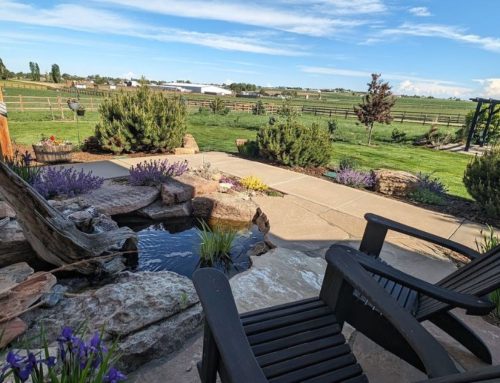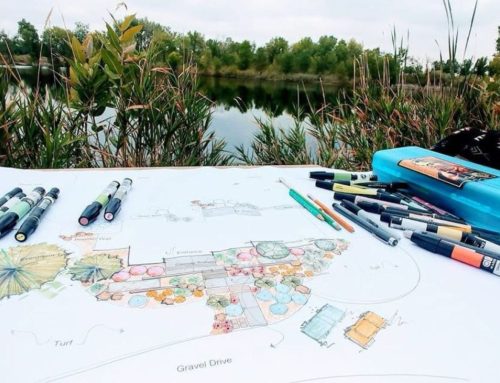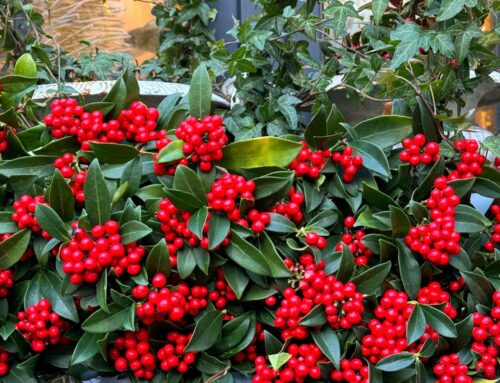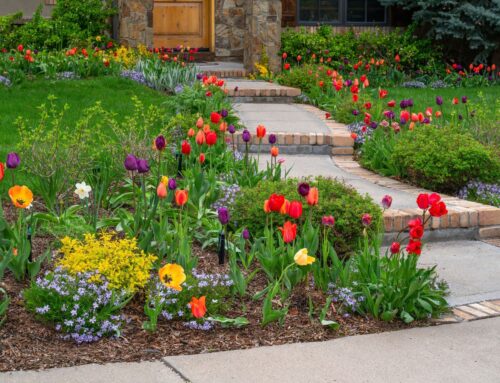Landscaping For Water Drainage in Colorado
Having drainage issues in your Colorado yard, not only causes standing water damage to your grass and the plantings, but it can also be a health hazard. Standing water often holds mosquito larvae and other undesirable pests, so it’s important to correct any yard drainage issues as soon as you notice them. Find out how you can improve water drainage in your landscaping, and around the perimeter of your Colorado home, using these tips.
Landscaping For Water Drainage in Colorado
You can turn landscaping for water drainage solutions into features that enhance your yard—and protect natural waterways. Ditches can be landscaped as swales that look like creek beds or small meadows. Gutter water can flow into rain gardens that provide a habitat for butterflies and birds. And driveways, patios, and walkways can be constructed of pervious paving that never puddles because water seeps through.
Swales
Swales are depressions that follow the contour around the base of a slope (natural or created), channeling storm water from one place to another. They filter runoff along the way by allowing it to sink into the soil. Plants on a swale’s gently sloping banks—and sometimes down the center of the channel itself—take up much of this water. Fast-draining soil is also key. The addition of a perforated pipe laid in gravel underneath can help handle heavy water flow.
Rain Gardens
Shallow catch basins planted as flower beds, rain gardens allow water to pool during a downpour, then slowly percolate into the soil. Where a swale is mostly a travel route for water, a rain garden is a destination. A fast-draining soil mix encourages water to sink in and promotes lush plant growth. Runoff may flow into a rain garden from a swale or pipe, or may simply run in from a sloping yard.
Construct a Creek Bed
A creek bed like this can channel water away from a low spot or direct runoff into a rain garden or dry well. With the right landscaping, the creek bed will look good even when it’s dry. You can solve drainage problems and create an attractive landscape feature at the same time with a dry creek bed. Build a creek bed to direct water away from a low spot in your yard. Or if the slope of the ground permits it, use a creek bed to drain a low spot.
Install a French Drain
A French drain is a versatile system for dealing with all kinds of drainage problems. It disperses water over a large area through a buried perforated pipe. The pipe must be surrounded by material that allows water to drain through. Conventionally this was gravel, but NDS sells a system called EZflow that includes the pipe and surrounding polystyrene aggregate in one convenient and lightweight package. A French drain system can be used alone or combined with a dry well.
Colorado’s Climate and Terrain
Colorado’s climate is characterized by its diversity, influenced by both its elevation and geographic location. The state experiences a semi-arid to arid climate in many areas, with the eastern plains being drier than the mountainous regions. Key features of Colorado’s climate and terrain include:
Elevation Variation
Colorado boasts an extensive range of elevations, from the eastern plains at around 3,500 feet to towering peaks exceeding 14,000 feet in the Rocky Mountains. This elevation gradient contributes to variations in temperature, precipitation, and snowpack accumulation.
Snowmelt and Runoff
Snowmelt from the Rocky Mountains is a crucial water source for Colorado’s rivers and reservoirs. In the spring and early summer, melting snow feeds into rivers, causing increased water flow and potential flooding in downstream areas.
Precipitation Patterns
Precipitation patterns vary across the state, with the western slope receiving less precipitation than the eastern plains. Most precipitation occurs in the form of snow in the mountains and as rain or thunderstorms in lower elevations.
Soil Types and Drainage
Colorado’s soil types range from sandy and rocky to clayey, influencing water infiltration rates and drainage capabilities. Some areas may have well-draining soils, while others may suffer from poor drainage, leading to waterlogging and erosion issues.
Common Water Drainage Challenges in Colorado
Despite its arid and semi-arid climate, Colorado faces several water drainage challenges, particularly in urban and residential areas. These challenges stem from various factors, including topography, land use practices, and climate variability. Common drainage issues in Colorado include:
-
Runoff and Erosion: Steep slopes and compacted soils can exacerbate runoff and erosion during heavy rainfall or snowmelt events. This can lead to soil erosion, loss of topsoil, and sedimentation in water bodies, affecting water quality and aquatic ecosystems.
-
Waterlogging and Poor Drainage: Some areas may experience waterlogging due to flat terrain, compacted soils, or inadequate drainage infrastructure. This can result in saturated soil conditions, standing water, and increased risk of property damage or structural instability.
-
Urbanization Effects: Urban development and impervious surfaces such as roads, parking lots, and rooftops can disrupt natural drainage patterns, causing increased surface runoff and flooding. Poorly designed or maintained drainage systems can further compound these issues in urban areas.
-
Snowmelt Management: Managing snowmelt runoff is a significant challenge in Colorado, especially in mountainous regions. Rapid snowmelt can overwhelm drainage systems, leading to flooding, property damage, and safety hazards for residents and motorists.
Addressing these drainage challenges requires a holistic approach that considers the region’s climate, terrain, and land use practices. Implementing sustainable drainage solutions and incorporating proper landscaping techniques can help mitigate these issues and promote water conservation and resilience in Colorado’s communities.
Solmauna creation + design | landscaping services in Colorado
We offer the best prices and services in terms of landscaping services, design, and installation in Loveland, Fort Collins, Estes Park, Timnath, Greeley, Johnstown, Longmount, boulder, Louisville, Broomfield, Erie, Docono, Lyons, Arvada, Colorado. Contact us Today.






